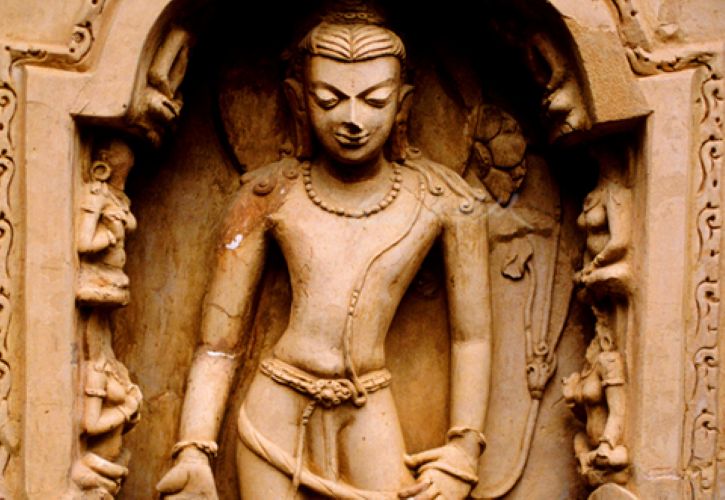THE GRACE OF EASTERN INDIA

Bodhisattva, Main Temple, Nalanda
Benoy K Behl
The thriving intellectual environment at Nalanda produced the most notable Buddhist thinkers. The 8th century saw the founding of the Pala Empire which ruled over most of Bengal and Bihar till the 12th century. Towards the end of the 8th century Dharmapala founded a great university in present day Bihar: The Vikramasila University, which was to rival the importance of Nalanda itself.
By this time, Buddhism had entered its third major phase: the Vajrayana school. It was this sophisticated philosophy which blossomed in the vibrant intellectual atmosphere of Vikramasila.
The emphasis in this period was on the intellectual quest. This is constantly reflected in the art. Previous art had been more naturalistic. Its focus had been on a gentleness, which moved us and dissolved our sense of the ego; which transported us through grace and ecstasy. The purpose of the art remained the same in this period. However, the dynamism of the intellect, which analyses the mental processes of the realization of the truth, came to the fore.
The many qualities of the Buddhahood within each of us and the steps on the path of enlightenment, came to be studied and presented in detail. The qualities which move us towards a realization of the Truth were presented in a manner which left no room for ambiguity or doubt. This was Vajrayana Buddhism, the Vehicle of the Thunderbolt, whose logic was “as clear and as striking as a clap of thunder”.
Such is the intellectual vigour which is presented in the art of the Pala period.
In this period of great intellectual vigour, the deities represent complex paths of realization. There appears to be no limit to the diversity in which the personal visualizations of the deities are presented.
In the Magadha region stands the Mahabodhi temple, which commemorates the event of the Enlightenment of the Buddha. Though greatly restored over the centuries, this 5th or 6th century temple is the oldest grand structure surviving in India. The architecture and sculptures would have inspired the Buddhist art of many Asian countries, from where pilgrims constantly came here.
A temple at Nalanda has reliefs on the plinth. These are among the very few stone sculptures surviving in situ of the Pala period. Great stupas were also made further east, in present-day Tripura and Bangladesh. Terracotta plaques with reliefs adorn the plinths which remain of the once-grand structures at Paharpur and at Pilak. These reflect Vajrayana developments in Buddhism and are full of life and vitality.
The path to salvation is now through intense meditation on the qualities of Buddhahood depicted in deities and complex diagrams.
Metal images were much easier to transport than large stone ones. It is these which traveled to Nepal, Tibet and further northwards, as well as to the countries of South East Asia. The sculptures transmitted the concepts and styles of Indic art far and wide in this period.
Under the Glimpses of Culture series, India Habitat Centre presents an online talk and
screening of the film ‘The Grace of Eastern India’ (an overview of art of Bihar, Bengal and Odisha)
produced by Benoy K Behl for Doordarshan on February 22, 6pm

